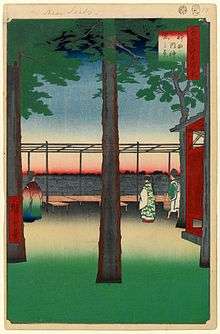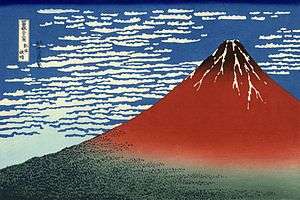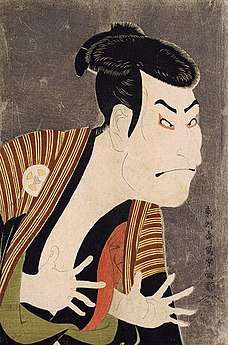Bokashi (printing)
Bokashi (Japanese: ぼかし) is a technique used in Japanese woodblock printmaking. It achieves a variation in lightness and darkness (value) of a single color or multiple colors by hand applying a gradation of ink to a moistened wooden printing block, rather than inking the block uniformly. This hand-application had to be repeated for each sheet of paper that was printed.

The best-known examples of bokashi are in the 19th-century ukiyo-e works of Hokusai and Hiroshige, in which the fading of Prussian blue dyes in skies and water create an illusion of depth.[1] In later work by Hiroshige, for example the series One Hundred Famous Views of Edo, most prints originally featured bokashi such as red-to-yellow-to-blue color sunrises.
Techniques
Gradations can be created on the blocks themselves using the itobokashi technique, or brushed on by hand using fukibokashi.[1] They can also be done freehand directly onto a print, without using a printing block.[2]
Fukibokashi
Fukibokashi requires gradations of ink to be applied to the printing block. This is not a precise technique; its results are inconsistent from print to print.[1]
The technique ichimonji bokashi (一文字ぼかし, "straight-line bokashi") is the one associated with the works of Hokusai and Hiroshige. Ink is applied only to one end of the brush's bristles, and the brush is drawn across the desired portion of the printing block; this area is first wetted with a zōkin cloth, so that the ink bleeds somewhat across the wet area. This creates a gradation at the width of the brush.[3]

Fine Wind, Clear Morning, Hokusai, c. 1830
In futa-iro bokashi (二色ぼかし) two colours are worked toward each other, achieved by applying two inks to opposite edges of the brush.[2] In hakkake bokashi a flat colour is printed, and then the same printing block is washed and re-brushed with a bokashi effect to overprint over the first; this technique is seen on the dark peak of Mount Fuji in Hokusai's Fine Wind, Clear Morning.[2]
Itabokashi
Itabokashi, or 'block shading,' is a technique used to produce ruffled edges on areas of color. It is produced by first cutting an area slightly larger than needed for a color, then abrading the edges of that area to make the transition from that color less sharp. This is commonly used in clouds and shading.[4]
Freehand techniques
Some techniques are performed freehand, without using a printing block, and results can vary considerably from print to print. Kumadori bokashi is used for finer details, such as around eyes, and requires the artist to draw with a brush loaded with ink on a wetted area; as with ichimonji bokashi, the bleeding of the ink into the water creates gradations. Atenashi bokashi is similar, requiring the wetting of areas to be inked, and is used for details such as clouds.[2]
References
- Salter 2001, p. 102.
- Salter 2001, p. 106.
- Salter 2001, p. 103.
- System, Japanese Architecture and Art Net Users. "JAANUS / itabokashi 板ぼかし". www.aisf.or.jp. Retrieved 2018-03-29.
Works cited
- Salter, Rebecca (2001). Japanese Woodblock Printing. University of Hawaii Press. ISBN 978-0-8248-2553-9.CS1 maint: ref=harv (link)
Further reading
- Newland, Amy Reigle. (2005). Hotei Encyclopedia of Japanese Woodblock Prints. Amsterdam: Hotei. ISBN 9789074822657; OCLC 61666175
External links
Japanese Woodblock Printing with Paul Binnie on YouTube A demonstration of bokashi starts at 55:00
